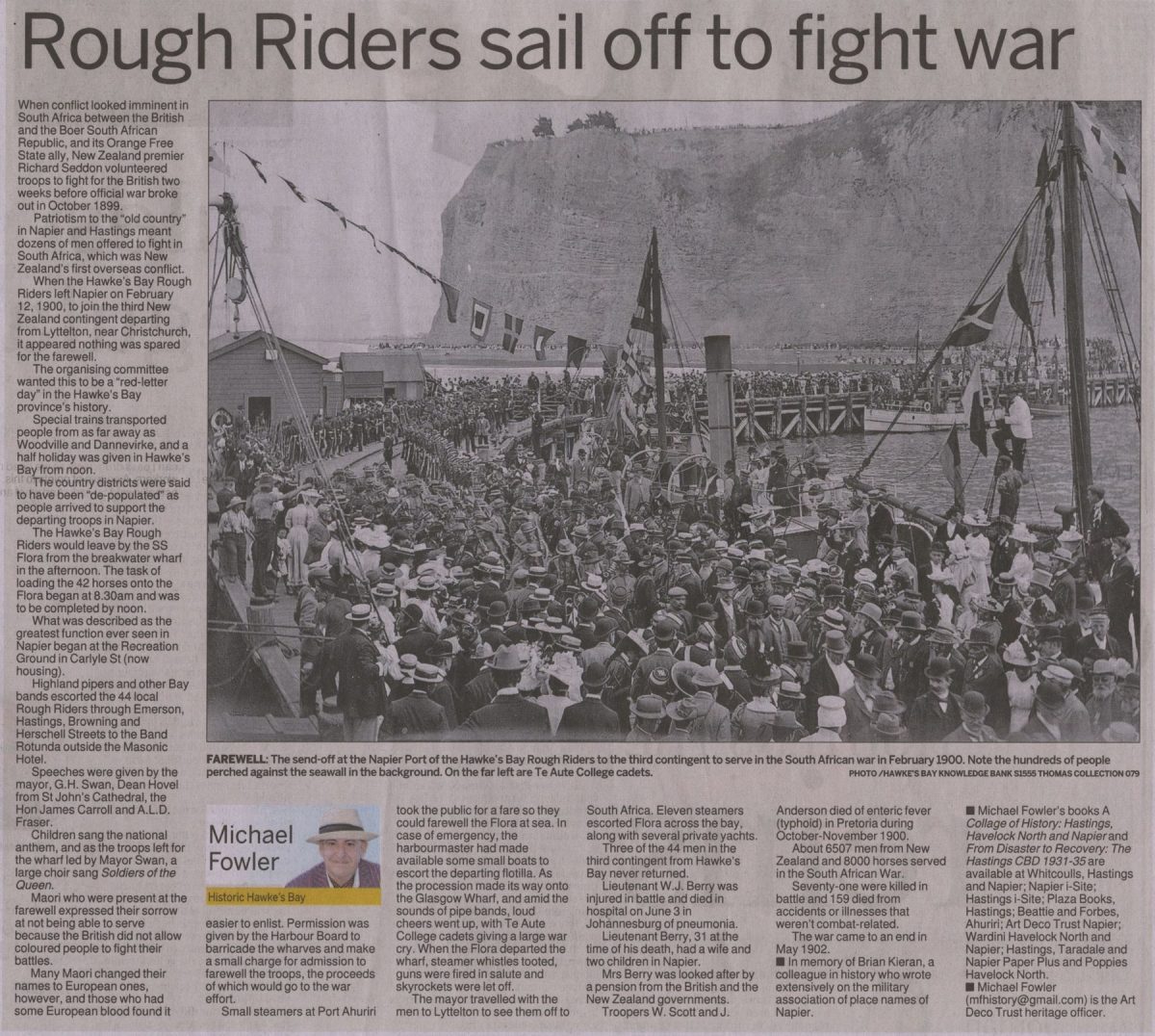Rough Riders sail off to fight war
When conflict looked imminent in South Africa between the British and the Boer South African Republic, and its Orange Free State ally, New Zealand premier Richard Seddon volunteered troops to fight for the British two weeks before official war broke out in October 1899.
Patriotism to the “old country” in Napier and Hastings meant dozens of men offered to fight in South Africa, which was New Zealand’s first overseas conflict.
When the Hawke’s Bay Rough Riders left Napier on February 12, 1900, to join the third New Zealand contingent departing from Lyttelton, near Christchurch, it appeared nothing was spared for the farewell.
The organising committee wanted this to be a “red-letter day” in the Hawke’s Bay province’s history.
Special trains transported people from as far away as Woodville and Dannevirke, and a half holiday was given in Hawke’s Bay from noon.
The country districts were said to have been “de-populated” as people arrived to support the departing troops in Napier.
The Hawke’s Bay Rough Riders would leave by the SS Flora from the breakwater wharf in the afternoon. The task of loading the 42 horses on to the Flora began at 8.30am and was to be completed by noon.
What was described as the greatest function ever seen in Napier began at the Recreation Ground in Carlyle St (now housing).
Highland pipers and other Bay bands escorted the 44 local Rough Riders through Emerson, Hastings, Browning and Herschell streets to the Band Rotunda outside the Masonic Hotel.
Speeches were given by the mayor, G. H. Swan, Dean Hovel from St John’s Cathedral, Hon James Carroll and A. L. D. Fraser.
Children sang the national anthem, and as the troops left for the wharf led by Mayor G H Swan, a large choir sang Soldiers of the Queen.
Maori who were present at the farewell expressed their sorrow at not being able to serve because the British did not allow coloured people to fight their battles.
Many Maori changed their names to European ones, however, and those who had some European blood found it easier to enlist.
Permission was given by the Harbour Board to barricade the wharves and make a small charge for admission to farewell the troops, the proceeds of which would go to the war effort.
Small steamers at Port Ahuriri took the public for a fare so they could farewell the Flora at sea. In case of emergency, the harbourmaster had made available some small boats to escort the departing flotilla. As the procession made its way on to the Glasgow Wharf, and amid the sounds of pipe bands, loud cheers went up, with the Te Aute College cadets giving a large war cry. When the Flora departed the wharf, steamer whistles tooted, guns were fired in salute and skyrockets were let off.
The mayor travelled with the men to Lyttelton to see them off to South Africa. Eleven steamers escorted Flora across the bay, along with several private yachts.
Three of the 44 men in the third contingent from Hawke’s Bay never returned.
Lieutenant W. J. Berry was injured in battle and died in hospital on June 3 in Johannesburg of pneumonia.
Lieutenant Berry, 31 at the time of his death, had a wife and two children in Napier.
Mrs Berry was looked after by a pension from the British and the New Zealand governments.
Troopers W. Scott and J. Anderson died of enteric fever (typhoid) in Pretoria during October/November 1900.
About 6507 men from New Zealand and 8000 horses served in the South African War.
Seventy-one were killed in battle and 159 died from accidents or illnesses that weren’t combat-related.
The war came to an end in May 1902.
In memory of Brian Kieran, a colleague in history who wrote extensively on the military association of place names of Napier.
Michael Fowler’s books A Collage of History: Hastings, Havelock North and Napier and From Disaster to Recovery: The Hastings CBD 1931-35 are available at Whitcoulls, Hastings and Napier; Napier i-Site; Hastings i-Site; Plaza Books, Hastings; Beattie and Forbes, Ahuriri; Art Deco Trust Napier; Wardini Havelock North and Napier; Hastings, Taradale and Napier Paper Plus and Poppies Havelock North.
Michael Fowler ([email protected]) is the Art Deco Trust heritage officer.
Photo caption –
Farewell: The send-off at the Napier Port of the Hawke’s Bay Rough Riders to the third contingent to serve in the South African war in February 1900. Note the hundreds of people perched against the seawall in the background. On the far left are Te Aute cadets.
PHOTO/HAWKE’S BAY KNOWLEDGE BANK S1555 THOMAS COLLECTION 079












Do you know something about this record?
Please note we cannot verify the accuracy of any information posted by the community.